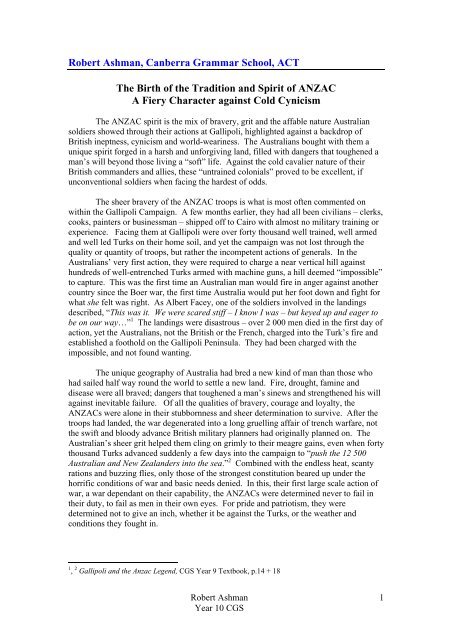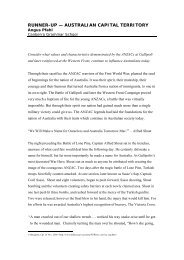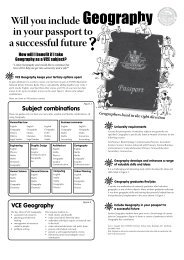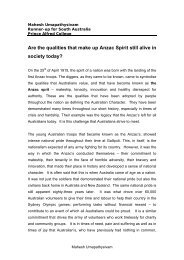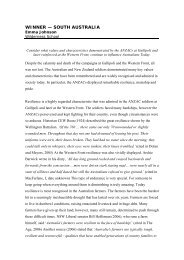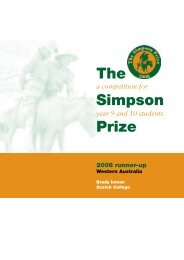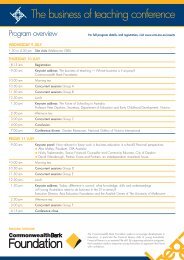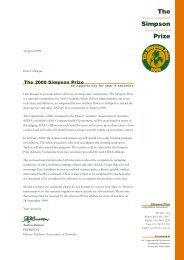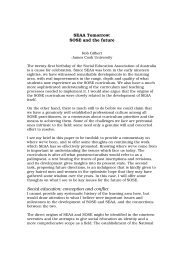Robert Ashman, Canberra Grammar School, ACT The Birth ... - afssse
Robert Ashman, Canberra Grammar School, ACT The Birth ... - afssse
Robert Ashman, Canberra Grammar School, ACT The Birth ... - afssse
Create successful ePaper yourself
Turn your PDF publications into a flip-book with our unique Google optimized e-Paper software.
<strong>Robert</strong> <strong>Ashman</strong>, <strong>Canberra</strong> <strong>Grammar</strong> <strong>School</strong>, <strong>ACT</strong><br />
<strong>The</strong> <strong>Birth</strong> of the Tradition and Spirit of ANZAC<br />
A Fiery Character against Cold Cynicism<br />
<strong>The</strong> ANZAC spirit is the mix of bravery, grit and the affable nature Australian<br />
soldiers showed through their actions at Gallipoli, highlighted against a backdrop of<br />
British ineptness, cynicism and world-weariness. <strong>The</strong> Australians bought with them a<br />
unique spirit forged in a harsh and unforgiving land, filled with dangers that toughened a<br />
man’s will beyond those living a “soft” life. Against the cold cavalier nature of their<br />
British commanders and allies, these “untrained colonials” proved to be excellent, if<br />
unconventional soldiers when facing the hardest of odds.<br />
<strong>The</strong> sheer bravery of the ANZAC troops is what is most often commented on<br />
within the Gallipoli Campaign. A few months earlier, they had all been civilians – clerks,<br />
cooks, painters or businessman – shipped off to Cairo with almost no military training or<br />
experience. Facing them at Gallipoli were over forty thousand well trained, well armed<br />
and well led Turks on their home soil, and yet the campaign was not lost through the<br />
quality or quantity of troops, but rather the incompetent actions of generals. In the<br />
Australians’ very first action, they were required to charge a near vertical hill against<br />
hundreds of well-entrenched Turks armed with machine guns, a hill deemed “impossible”<br />
to capture. This was the first time an Australian man would fire in anger against another<br />
country since the Boer war, the first time Australia would put her foot down and fight for<br />
what she felt was right. As Albert Facey, one of the soldiers involved in the landings<br />
described, “This was it. We were scared stiff – I know I was – but keyed up and eager to<br />
be on our way…” 1 <strong>The</strong> landings were disastrous – over 2 000 men died in the first day of<br />
action, yet the Australians, not the British or the French, charged into the Turk’s fire and<br />
established a foothold on the Gallipoli Peninsula. <strong>The</strong>y had been charged with the<br />
impossible, and not found wanting.<br />
<strong>The</strong> unique geography of Australia had bred a new kind of man than those who<br />
had sailed half way round the world to settle a new land. Fire, drought, famine and<br />
disease were all braved; dangers that toughened a man’s sinews and strengthened his will<br />
against inevitable failure. Of all the qualities of bravery, courage and loyalty, the<br />
ANZACs were alone in their stubbornness and sheer determination to survive. After the<br />
troops had landed, the war degenerated into a long gruelling affair of trench warfare, not<br />
the swift and bloody advance British military planners had originally planned on. <strong>The</strong><br />
Australian’s sheer grit helped them cling on grimly to their meagre gains, even when forty<br />
thousand Turks advanced suddenly a few days into the campaign to “push the 12 500<br />
Australian and New Zealanders into the sea.” 2 Combined with the endless heat, scanty<br />
rations and buzzing flies, only those of the strongest constitution beared up under the<br />
horrific conditions of war and basic needs denied. In this, their first large scale action of<br />
war, a war dependant on their capability, the ANZACs were determined never to fail in<br />
their duty, to fail as men in their own eyes. For pride and patriotism, they were<br />
determined not to give an inch, whether it be against the Turks, or the weather and<br />
conditions they fought in.<br />
1 , 2 Gallipoli and the Anzac Legend, CGS Year 9 Textbook, p.14 + 18<br />
<strong>Robert</strong> <strong>Ashman</strong><br />
Year 10 CGS<br />
1
Humour was an important part of an ANZACs day to day life. Laughter was a<br />
denial of oblivion; a reaffirmer that life still existed even when surrounded by death. At<br />
first, war was seen as a “great adventure” by the Australians, a lark to go and be there or<br />
else not be a man, an ominous echo of the “it’ll be over by Christmas” attitude the British<br />
held. As the war progressed and that daydream was shattered, their humour became<br />
bitterer, a façade they could hide behind to deny their inevitable end. Yet this humour<br />
never became cruel, as it so often does in war, and was often shared with their enemy,<br />
whom they respected above their inept British officers. As a Lieutenant fighting the<br />
Turks described, “… there must have been a German officer approaching, for all of a<br />
sudden the Turks began signalling to our chaps to get down in their trenches… then a<br />
machine gun began to play along the parapet end to end…” 3 From the innocent laughter<br />
of the naïve colonialist, the natural humour of the ANZACs deepened to a mutual respect<br />
of their enemy and a denial of surrounding death.<br />
It was to be the incredible inept, pessimistic and cynical backdrop of the British<br />
commanders that would make the ANZAC spirit a legend. Australian soldiers were<br />
regarded as expendables, cannon fodder for the Turks while the British tried high<br />
strategy. <strong>The</strong> whole planning and execution of the campaign was interrupted by logistic<br />
and strategic problems, blind stubbornness and a disparaging attitude held by the British<br />
against their allies. As B.H Liddell Hart comments, “No heed was given to the wider<br />
aspects of the plan – its immediate and potential needs in men, guns, ammunition and<br />
supplies…” 4 <strong>The</strong> British still saw the Australians as convicts; untrained colonialists fit<br />
only for suicide attacks and landings. <strong>The</strong> terrible attitude the British took towards their<br />
Australian allies is described by historian Bill Gammage, “All the tragic waste of the<br />
Great War was contracted into their [Australian Light Horseman] passing, for as they<br />
died the English troops at Sulva, plainly visible from the Nek, were making tea.” 5<br />
In today’s conflicts, the ANZAC spirit has changed from being the bravery,<br />
determination and humour in the face of terrible odds to the compassion and integrity in<br />
the modern theatre of war. No longer facing hard but tangible foes, Australian soldiers<br />
now deal with the tough issue of giving humanitarian aid to victims of their profession,<br />
perhaps a more demanding task than that faced at Gallipoli. Australians are now<br />
deployed on primarily humanitarian missions, such as those to East Timor, the Solomon<br />
Islands and countries affected by the Boxing Day tsunami. <strong>The</strong>re, instead of fighting,<br />
Australian soldiers are keeping the peace with the help of the UN. This has bred a new<br />
spirit of compassion for the victims of war and disasters, support for their shattered lives<br />
and a protection against their oppressors. Also deployed in Iraq, the Australian’s soldiers’<br />
efforts are more directed to giving aid than fighting insurgents, such as rebuilding the<br />
shattered capital of Baghdad and giving support to those in need. 6 Though only a few<br />
hundred Australians have been deployed world-wide, they have been recognised for their<br />
exceptional empathy and help for the victims of war, rather than creating new ones.<br />
<strong>The</strong> ANZAC spirit of bravery, grit, determination and mateship, silhouetted<br />
against a background of British cynicism, incompetence and high-handed attitude to life<br />
still exists in today’s conflicts. Some would argue the ANZAC legend has been<br />
sensationalised by the media; that it’s true meaning is dead in our globalised world that<br />
needs no heroes. Still, the ANZAC legend of humanity in war still exists in humanity’s<br />
3 Gallipoli: Attitude to the Turks, <strong>The</strong> Gallipoli Campaign [Simmelhaig, Spencely]<br />
4 Gallipoli and the Anzac Legend, CGS Year 9 Textbook, p.17<br />
5 <strong>The</strong> Attack at the Nek, <strong>The</strong> Broken Years [Bill Gammage]<br />
6 Red Kangaroo Leaves Its Mark in Iraq, Media Release from the office of the Minister for Defence<br />
<strong>Robert</strong> Hill. Available: http://www.minister.defence.gov.au/HillTpl.cfm?CurrentId=5204<br />
<strong>Robert</strong> <strong>Ashman</strong><br />
Year 10 CGS<br />
2
wars, and Australian soldiers still show that rare mix of compassion for their enemies, a<br />
willingness to go beyond patriotism and a resolve to hold till the end wherever they fight.<br />
<strong>Robert</strong> <strong>Ashman</strong><br />
Year 10 CGS<br />
3
Bibliography<br />
<strong>School</strong> Textbook / Brick:<br />
‣ Year 9 History: Gallipoli and the Anzac Legend. Compilation of sections<br />
from books, newspapers and encyclopaedias. Used articles:<br />
o S. Johnston, 1981: Experiences of the Great War. Quote from Albert<br />
Facey, p. 255 – 7 (Excerpt on p. 18 of brick)<br />
o S. Johnston, 1981: Experiences of the Great War, (Excerpt on p.19 of<br />
brick)<br />
o S. Johnston, 1981: Experiences of the Great War. Quote from B.H<br />
Liddell Hart, p. 169 (Excerpt on p. 17 of brick)<br />
o Simmelhaig and Spencely, <strong>The</strong> Gallipoli Campaign: Attitude to the<br />
Turks (excerpt). Quote from Lt. J C Price.<br />
o William Gammage, 1974: <strong>The</strong> Broken Years: <strong>The</strong> Attack at the Nek.<br />
Media Release (Website):<br />
‣ Media Release: Office of Senator <strong>Robert</strong> Hill, Minister for Defence. “Red<br />
Kangaroo Leaves its Mark in Iraq”. Published 21 October 2005. Available:<br />
http://www.minister.defence.gov.au/HillTpl.cfm?CurrentId=5204<br />
<strong>Robert</strong> <strong>Ashman</strong><br />
Year 10 CGS<br />
4


